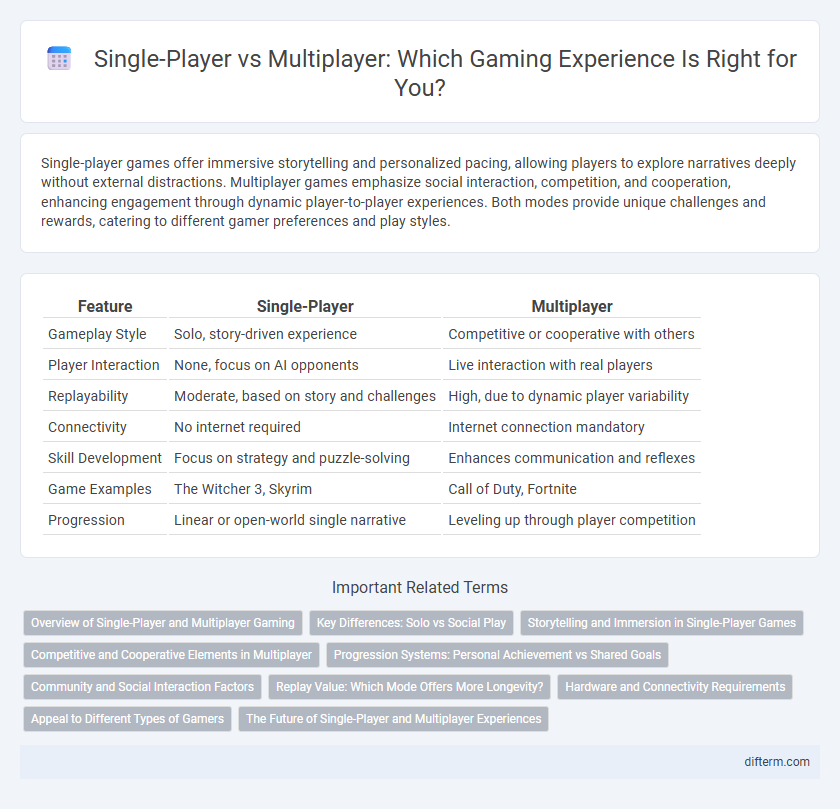Single-player games offer immersive storytelling and personalized pacing, allowing players to explore narratives deeply without external distractions. Multiplayer games emphasize social interaction, competition, and cooperation, enhancing engagement through dynamic player-to-player experiences. Both modes provide unique challenges and rewards, catering to different gamer preferences and play styles.
Table of Comparison
| Feature | Single-Player | Multiplayer |
|---|---|---|
| Gameplay Style | Solo, story-driven experience | Competitive or cooperative with others |
| Player Interaction | None, focus on AI opponents | Live interaction with real players |
| Replayability | Moderate, based on story and challenges | High, due to dynamic player variability |
| Connectivity | No internet required | Internet connection mandatory |
| Skill Development | Focus on strategy and puzzle-solving | Enhances communication and reflexes |
| Game Examples | The Witcher 3, Skyrim | Call of Duty, Fortnite |
| Progression | Linear or open-world single narrative | Leveling up through player competition |
Overview of Single-Player and Multiplayer Gaming
Single-player gaming offers immersive storytelling and personalized experiences, allowing players to engage deeply with narrative-driven content at their own pace. Multiplayer gaming emphasizes social interaction and competitive play, fostering teamwork, communication, and dynamic challenges among players worldwide. Both modes cater to different preferences, with single-player focusing on solo exploration and multiplayer enhancing community engagement through online connectivity.
Key Differences: Solo vs Social Play
Single-player games emphasize individual skill, personal storylines, and immersive solo experiences that allow players to progress at their own pace without external influence. Multiplayer games foster social interaction, team strategies, and dynamic competition, requiring communication and collaboration among participants. The core difference lies in the player's engagement mode: solitary achievement versus shared challenges and cooperative gameplay.
Storytelling and Immersion in Single-Player Games
Single-player games often deliver deep storytelling through carefully crafted narratives that immerse players in rich, personalized worlds. These experiences enable emotional connections with characters and plot developments that adapt to individual choices, enhancing immersion. The focused design of single-player campaigns allows for uninterrupted exploration and a more engaging, story-driven gameplay experience compared to multiplayer modes.
Competitive and Cooperative Elements in Multiplayer
Multiplayer gaming offers competitive elements where players engage in head-to-head matches, testing skills, strategies, and reflexes in real-time environments. Cooperative gameplay fosters teamwork, requiring communication and coordination to achieve shared objectives, enhancing social interaction and collective problem-solving. These dynamic multiplayer modes contrast with single-player experiences by emphasizing player interaction and adaptability in evolving game scenarios.
Progression Systems: Personal Achievement vs Shared Goals
Single-player games emphasize personal achievement through individualized progression systems such as skill trees, experience points, and unlockable content that reflect player mastery and narrative advancement. In contrast, multiplayer games often incorporate shared goals, cooperative challenges, and synchronized leveling systems designed to foster teamwork, dynamics, and collective success. These differing progression systems impact player motivation by prioritizing self-improvement in solo campaigns and collaboration in multiplayer environments.
Community and Social Interaction Factors
Multiplayer games foster strong community bonds and social interaction, creating immersive experiences through teamwork, competition, and communication. Single-player games emphasize personal narrative and individual skill development, appealing to those seeking solitude or a deep story. Social features like voice chat, guilds, and cooperative missions significantly enhance player engagement and longevity in multiplayer environments.
Replay Value: Which Mode Offers More Longevity?
Single-player games often provide structured narratives and curated experiences that can be completed once, limiting replay value but offering deep story immersion. Multiplayer modes extend longevity through dynamic interactions, competitive challenges, and evolving communities that encourage repeated play. Games like "The Witcher 3" deliver rich single-player content, whereas titles such as "Call of Duty" thrive on multiplayer engagement, showcasing how social dynamics drive prolonged interest.
Hardware and Connectivity Requirements
Single-player games generally demand less powerful hardware and minimal connectivity, making them accessible on a wide range of devices without constant internet access. Multiplayer games require robust hardware capabilities to support real-time interactions and high-quality graphics, coupled with stable, high-speed internet connections to ensure smooth gameplay and low latency. Network infrastructure, including bandwidth and server response times, plays a critical role in delivering a seamless multiplayer experience.
Appeal to Different Types of Gamers
Single-player games attract gamers who prefer immersive storylines, personal achievement, and a controlled pace that allows for deep exploration and character development. Multiplayer games appeal to those who seek social interaction, competitive challenges, and cooperative experiences that foster teamwork and community building. Understanding these preferences helps developers tailor gaming experiences to diverse player motivations and engagement styles.
The Future of Single-Player and Multiplayer Experiences
The future of gaming will blend innovative single-player narratives with dynamic multiplayer interactions, leveraging advancements in AI and cloud technology to create more immersive and personalized experiences. Single-player games will continue to evolve with deeper storylines and adaptive gameplay that respond to individual player choices, while multiplayer platforms will emphasize expansive, interconnected worlds fostering social engagement and competitive play. Enhanced cross-platform compatibility and real-time content updates will further unify these experiences, offering gamers a seamless transition between solo exploration and cooperative or competitive multiplayer modes.
single-player vs multiplayer Infographic

 difterm.com
difterm.com